The Economics and Statistics Division maintains archives of previous publications for accountability purposes, but makes no updates to keep these documents current with the latest data revisions from Statistics Canada. As a result, information in older documents may not be accurate. Please exercise caution when referring to older documents. For the latest information and historical data, please contact the individual listed to the right.
<--- Return to Archive
For additional information relating to this article, please contact:
August 07, 2020LABOUR MARKET TRENDS - JULY 2020 Labour force survey results reflect the period from July 12 to 18, when public health restrictions had been substantially eased in most parts of the country. Business and workplaces continued to re-open with physical distancing and other requirements in place. Large gatherings continue to be limited.
Nova Scotia's seasonally adjusted employment level was up 3,400 (+0.8%) in July following on the recovery of 8,600 jobs in May and 26,800 in June. Nova Scotia’s employment had previously declined 50,600 in April and 24,800 in March.
Nova Scotia’s employment remains lower by 34,500 (-7.3%) compared to February 2020 as the COIVD-19 pandemic and public health measures to contain it continue to impact the labour market.
Nova Scotia’s labour force decreased 8,500 (-1.7%) to 489,200 for July. This is the first month during COVID-19 pandemic in which Nova Scotia’s labour force and employment moved in opposite directions. The labour force in July 2020 is smaller by 21,700 (-4.2%) than February 2020. The number of unemployed persons was down 11,800 compared to June and is 13,000 higher than February. With employment growing and labour force declining, the unemployment rate decreased 2.2 percentage points to 10.8 per cent July.
The population not in the labour force increased 9,300 compared to last month. Compared to February 2020, there are an additional 25,000 persons not in the labour force and 13,000 unemployed.
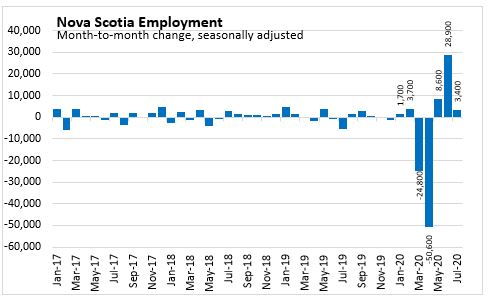


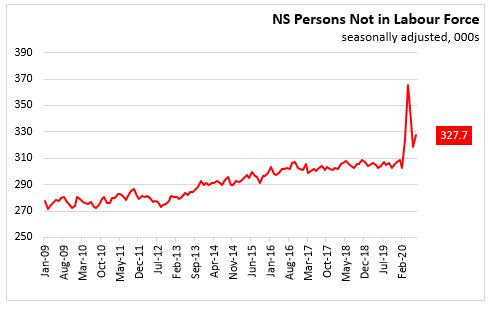
In July, full-time employment declined 700 (-0.2%) while part-time employment increased 4,000 (+5.3%). Employment since February 2020 is lower by 22,800 (-6.0%) in full-time jobs and -11,800 (-13.0%) in part-time employment.
With the population steady (+0.1%) in July 2020, the declined in labour force decreased the participation rate 1.1 percentage points to 59.9 per cent. The participation rate remains 2.9 percentage points below the level observed in February 2020. The employment rate was up 0.3 percentage points to 53.4 per cent in July 2020 but remains 4.5 percentage points below February 2020.
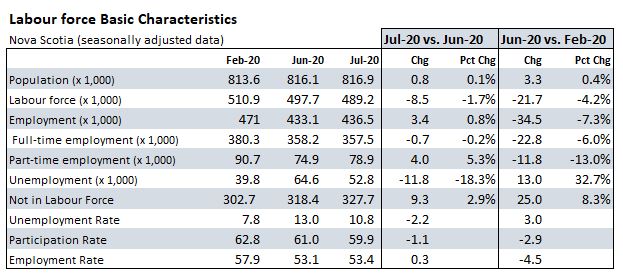
In addition to those who have lost employment since February 2020, there are elevated numbers of persons who are counted as employed, but had zero hours (and not for routine reasons like vacation, maternity/parental leave, labour dispute) or had their hours cut by 50 per cent or more. In July 2020 in Nova Scotia there were 40,500 persons employed but at less than 50 per cent of their usual hours (including zero hours), down from 48,700 in June but still elevated compared to 19,700 in February. Combined with those who have lost their employment, this amounts to about 11.7 per cent of Nova Scotia’s February 2020 employment level; down from 26.3 per cent in May and 14.2 per cent in June. The largest total employment/hour impact in July 2020 was in Ontario at 14.4 per cent of February's employment level still experiencing an impact. The smallest change was in New Brunswick (5.0%).
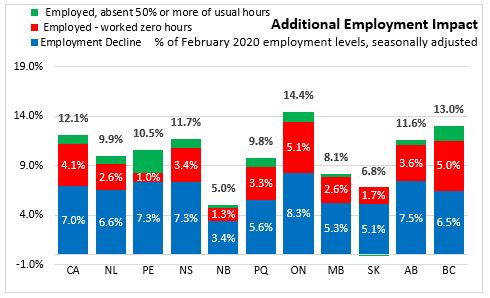
Statistics Canada reported in supplemental information that Nova Scotia had an increase of 13,000 (Feb-20 to Jul-20) of those who were not in the labour force but wanted to work. This is down from the 35,100 increase when comparing Feb-20 to May-20 The labour underutilization rate (COVID-19 impact definition) is the proportion of the potential labour force (labour force + those wanting work) that is unemployed, not in labour force but wanted work or employed but have lost the majority of their usual hours.
The percentage increase observed in every province in March and April has started to come down in the past three months. In February 2020, Nova Scotia's labour underutilization rate was 13.9 which increased to 36.8 per cent in April 2020 and declined to 23.2 per cent by July. The current highest labour underutilization rate is in Newfoundland and Labrador (29.1%) and the lowest rate is in Manitoba (17.4%).

Age Cohorts
After improvements in the participation rate across all age groups in June, participation rates for younger and core aged Nova Scotians declined in July. The participation rate for younger Nova Scotians (15-24) decreased 2.2 percentage points to 64.9 per cent in July – 8.1 percentage points below the level observed in February 2020. For core aged Nova Scotians (25-54), the participation rate was down 1.9 percentage points to 84.5 per cent (down 3.4 percentage points since February), and for older workers the participation rate was unchanged at 33 per cent (down 0.5 percentage points since February).
From June to July employment rates were up for youth (+1.8 percentage points), core-aged (+0.2 percentage points) and older workers (+0.1 percentage points). Compared with February, employment rates for youth were down 11.7 percentage points while employment rate were down 4.4 percentage points for core aged workers and 2.2 percentage points for older workers.
From June to July, unemployment rates decreased 5.4 percentage points to 20.8 per cent for ages 15-24, decreased 2.3 percentage points to 8.0 per cent for ages 25 to 54, and increased 0.1 percentage points to 11.9 per cent for those over 55.
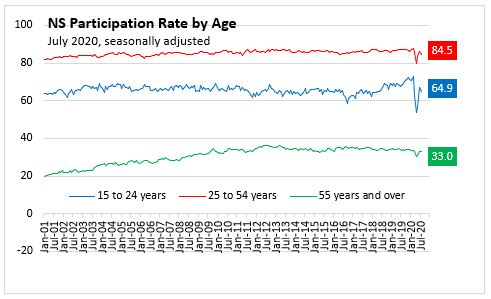
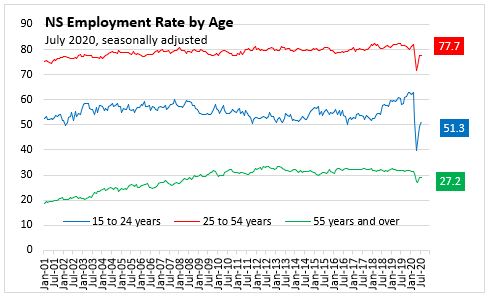
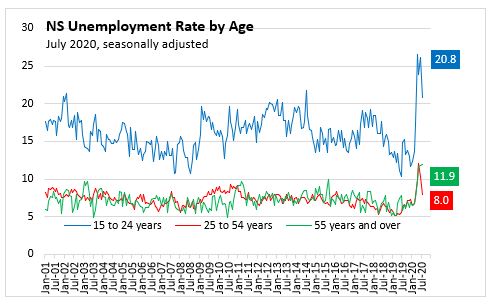
Comparing July 2020 to February 2020, the decline in employment mostly lines up with the labour force decline for youth and core aged workers. For those over 55 the employment decline shows up in elevated unemployment instead of a decrease in the labour force.

Males and Females
For July 2020, the monthly participation rate decreased by 1.0 percentage points among Males to 63.3 per cent and by 1.2 percentage points among Females to 56.7 per cent.
The employment rate was up 0.1 percentage points for Males and by 0.6 percentage points for Females.
The monthly unemployment rate decreased by 1.5 percentage points among Males to 11.4 per cent and decreased by 2.9 percentage points to 10.2 per cent for Females.
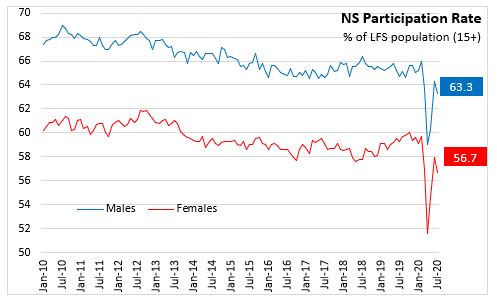
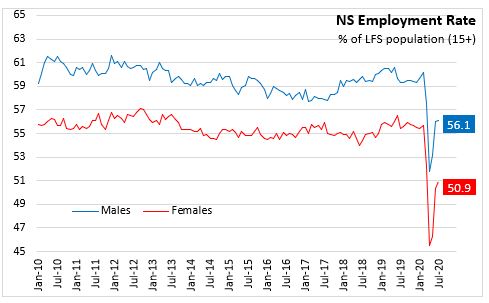
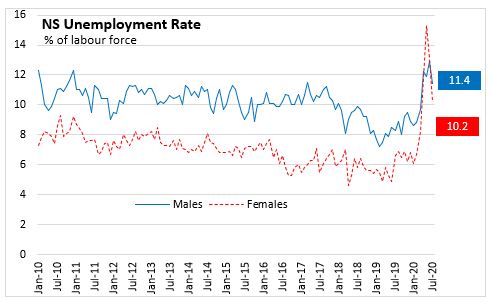
Compared with February 2020, male labour force is down 9,700 (-3.7%) while female labour force is down 11,800 (-4.7%). Male employment is down 15,200 (-6.4%) while female employment is down 19,300 (-8.3%). The number of unemployed is up 5,500 for males and 7,500 for females. The male population not in the labour force increased by 11,300, while the number of females not in the labour force grew by 13,500.

Sectors and Industries
Monthly employment increases in July were mostly among public sector (+3,800) employees. Self-employment (+100) and private sector employment (-500) were little changed in July. Compared to February 2020, employment remains lower in the private sector (-42,400) and self-employed (-900); while public sector employment (+8,600) was higher. (Totals do not add due to rounding).
For July 2020, goods-producing sector employment ( -700) was down with declines in all subsectors except forestry/fishing/mining. Services-producing employment recovered with an increase of 4,100 jobs in July. The largest employment increases were in educational services (+2,600), business, building and other support services (+1,400) and professional, scientific, and technical services (+1,100). Employment declined in accommodation and food services (-2,500) in July.

Employment since February 2020 remains 6,900 lower in goods-producing industries with the lower employment levels concentrated in construction (-3,500) and manufacturing (-4,500). Service-producing employment is lower by 27,600 since February 2020 with the lower levels in wholesale and retail trade (-10,800) and accommodation and food service (-12,800) accounting for around 85 per cent of the total service sector decline. Employment levels in July 2020 are also lower in information, culture and recreation (-3,100), transportation and warehousing (-1,700) building, building and other support services (-1,200), health care and social assistance (-800), other services (-700), and finance, insurance, real estate and leasing (-300). Employment levels are higher in July 2020 than February 2020 in educational services (+1,300), professional, scientific, and technical services (+1,200) and public administration (+1,100).
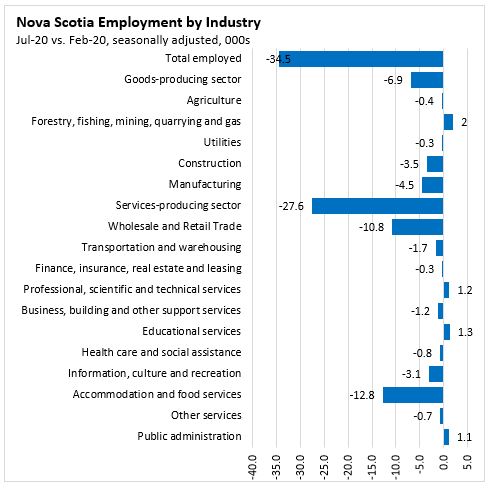

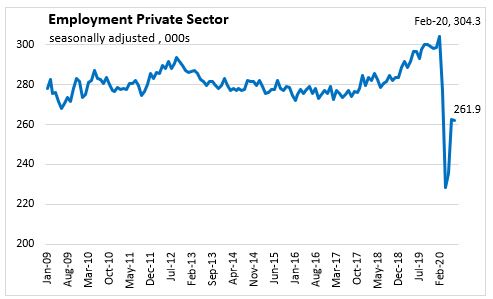
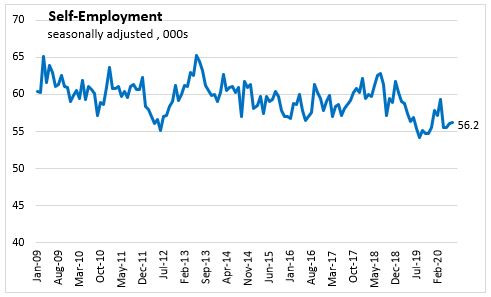
Regions – July 2020 vs. July 2019 (unadjusted 3 month moving average)
Comparing July 2020 with July 2019, Cape Breton employment is down 5,200 while the labour force decreased by 3,000. The number of unemployed increased 2,200 and the unemployment rate increased 4.7 percentage points to 16.8 per cent.
For the North Shore region, the labour force decreased by 6,600 while employment decreased 10,900. With labour force declining less than employment, the number of unemployed increased by 4,200. This caused a 6.6 percentage points increase in the unemployment rate from 6.3 per cent to 12.9 per cent. There are 6,900 more persons not in the labour force compared to last year.
The Annapolis Valley reported a decrease of 5,400 in labour force, while employment fell by 7,600. Unemployment was up 2,300 and the net result was an increase in the unemployment rate by 4.6 percentage points to 10.5 per cent. In July, there were 5,800 more persons not in the labour force in Annapolis Valley compared to the same month a year ago.
Compared to July 2019, the Southern region had an increase of 600 in employment along with an increase of 3,500 in the labour force. The unemployment rate increased 4.7 percentage points to 12.2 per cent in July.
Halifax experienced a decline of 4,800 in the labour force along with a decline of 19,300 in employment. With unemployment rising 14,300, there was an increase of 5.7 percentage points in the unemployment rate from 5.0 per cent to 10.7 per cent in Halifax. The number of persons not in the labour force increased 13,800 in Halifax compared to last year.
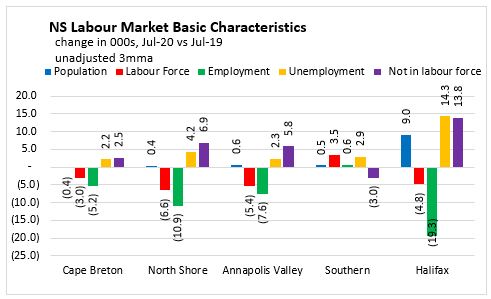

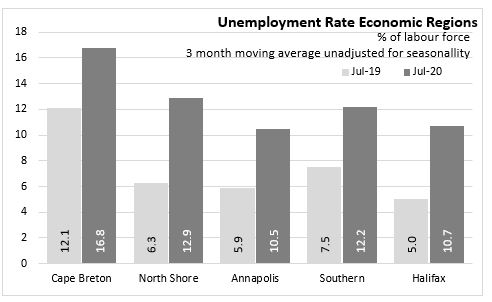
Provincial Comparisons
All provinces, except New Brunswick, report increases in employment in July. The largest employment increases was in Alberta (+3.2%) and nationally employment was up 2.4 per cent.

Compared to February 2020, the labour force remains lower in all provinces and the US. The largest decline in the labour force since February 2020 has been in Nova Scotia (-4.2%). The largest employment decline since February is in Ontario (-8.3%) and the United States (-8.4%). The smallest employment decline since February 2020 is in New Brunswick (-3.4%).

Unemployment rates declined in July 2020 in all the provinces and the United States. The highest unemployment rate for July 2020 is in Newfoundland and Labrador at 15.6 per cent and the lowest is in Manitoba at 8.2 per cent. Canada’s unemployment rate was 10.9 per cent in July 2020.
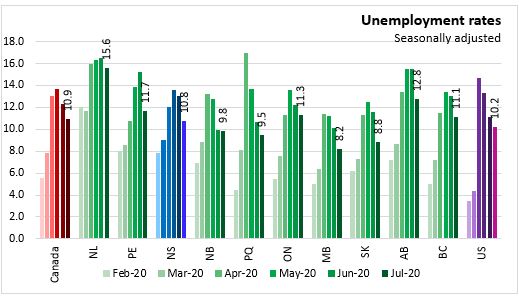
National Comparisons: Cities (Monthly, 3 month moving average)
The unemployment rate for Halifax Census Metropolitan Area (CMA) in July 2020 was 10.9 per cent (seasonally adjusted 3 month moving average). Moncton at 8.2 per cent had the lowest unemployment rate among CMAs while the highest was in Calgary (15.5 per cent).
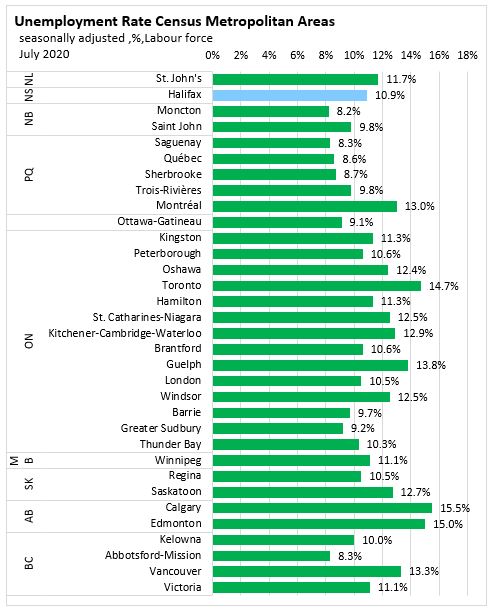
The seasonally adjusted employment rate for Halifax was 59.0 per cent, up 2.2 percentage points compared to last month. Peterborough, Ontario (46.6 per cent) had the lowest employment rate, while Barrie, Ontario (66.5 per cent) had the highest.
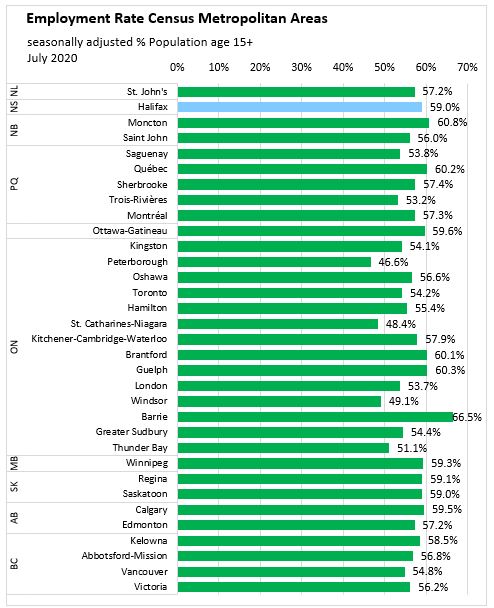
Halifax’s employment (3 month moving average) for July 2020 was up 4.2 percent compared to the June 2020 result. The employment level (May-July average compared to April-June average) was up in all CMAs this month with the largest increase in Windsor (+7.5%) and the smallest in Peterborough (+0.8%).
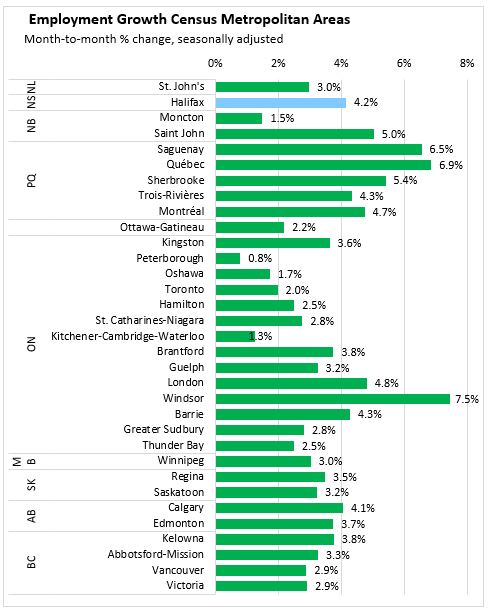
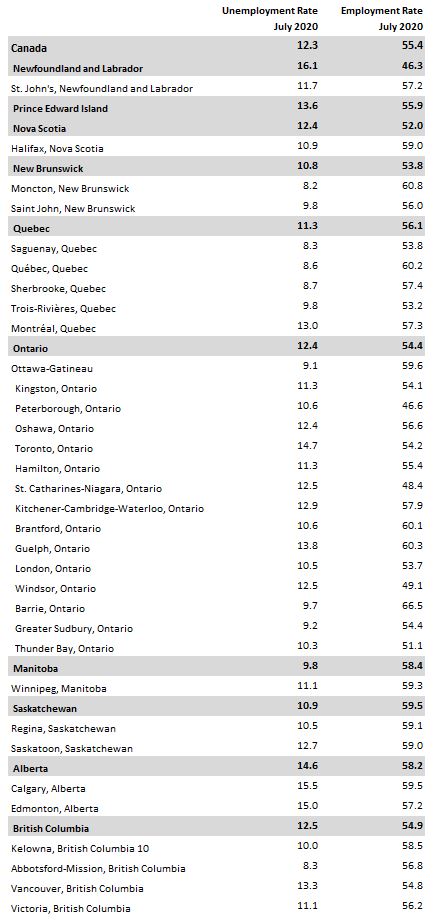
Note: Seasonally adjusted, 3 month average.
Sources:
Statistics Canada. Table 14-10-0287-01 Labour force characteristics, monthly, seasonally adjusted and trend-cycle, last 5 months
Statistics Canada. Table 14-10-0294-01 Labour force characteristics by census metropolitan area, three-month moving average, seasonally adjusted and unadjusted, last 5 months
Statistics Canada. Table 14-10-0293-01 Labour force characteristics by economic region, three-month moving average, unadjusted for seasonality, last 5 months
Statistics Canada. Table 14-10-0355-01 Employment by industry, monthly, seasonally adjusted and unadjusted, and trend-cycle, last 5 months (x 1,000)
Statistics Canada. Table 14-10-0288-01 Employment by class of worker, monthly, seasonally adjusted and unadjusted, last 5 months (x 1,000)
<--- Return to Archive